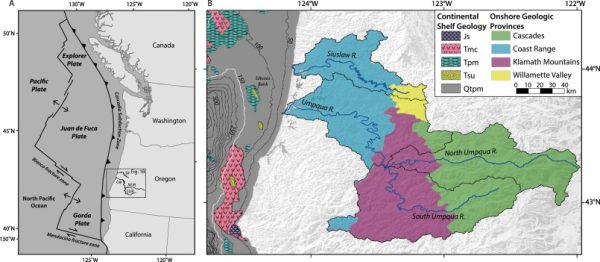Postdoc Dr. Shannon Klotsko and master’s student Matthew Skakun co-authored a paper with Dr. Jillian Maloney and others that was just published in Marine Geology. Klotsko is now an assistant professor at University of North Carolina Wilmington and Skakun is working as a geologist for a local firm.

The lowstand extensions of two fluvial systems from the Cascadia subduction margin are investigated using high-resolution seismic reflection data to determine the relative controls on paleodrainage morphology. We document distinct differences between the two systems, located ~40 km apart, attributed to underlying structure and lithology, shelf gradient, and drainage basin characteristics.
A cross-shelf valley exists for only one of the drainage systems, the Umpqua River. The outer shelf part of the valley is a syncline, which formed a natural structural low for lowstand drainage, while the inner shelf part of the valley exhibits incision and is associated with a mid-shelf convex change is slope. The other drainage system, the Siuslaw River, did not develop an across-shelf valley and is only denoted in the seismic data by an erosional subaerial unconformity.
Structural trends are perpendicular to cross-shelf drainage, supporting a more anastomosing stream morphology for the paleo-Siuslaw. The shelf edge for this system was not exposed for a long period of time during the last lowstand, preventing substantial outer shelf incision. Differences in fluvial elevation, discharge, and hinterland geology, also played a role in the cross-shelf morphologies of the paleo-Umpqua and paleo-Siuslaw.
These results highlight how controls on lowstand paleodrainage morphology can change over short distances on an active margin.

